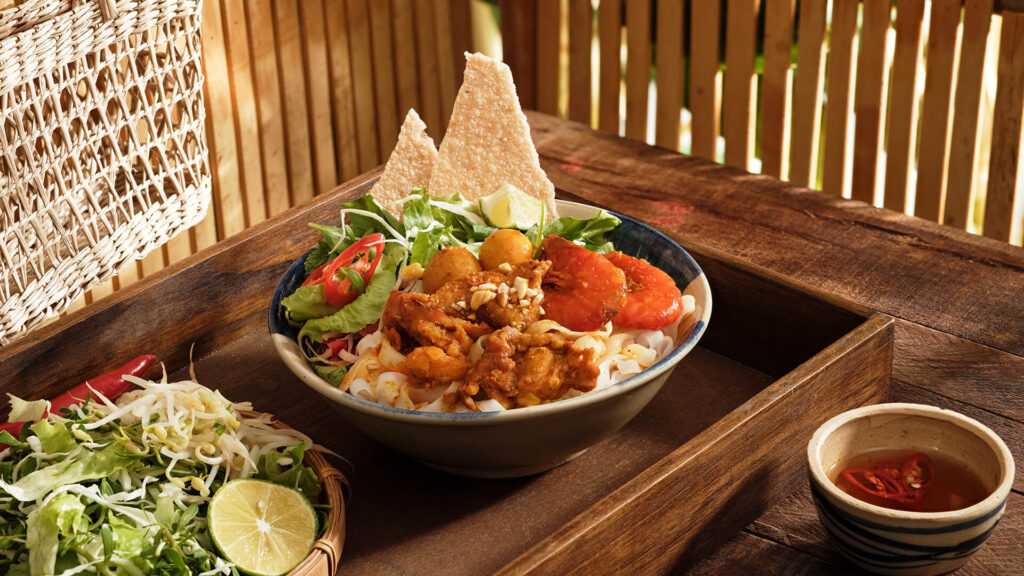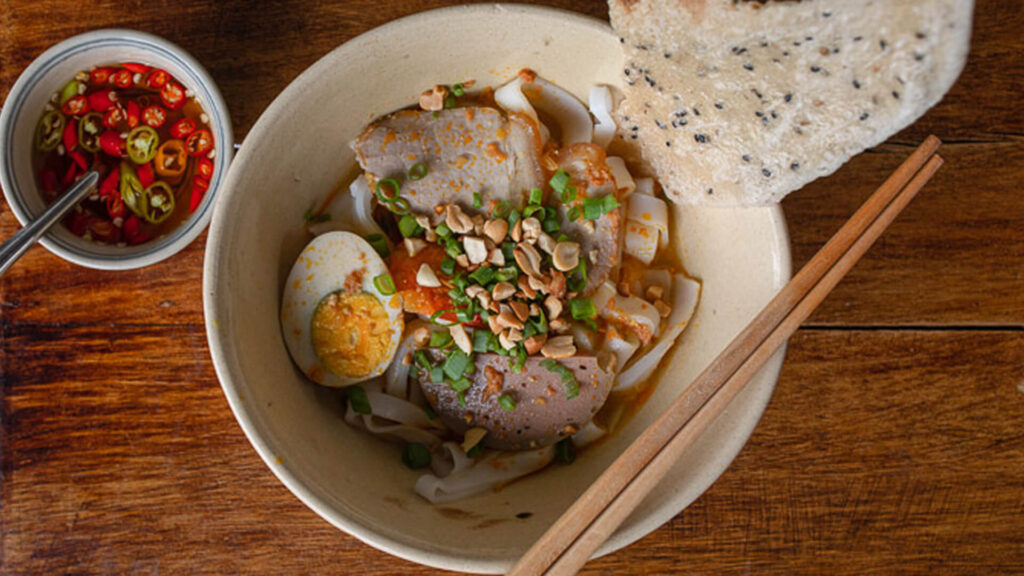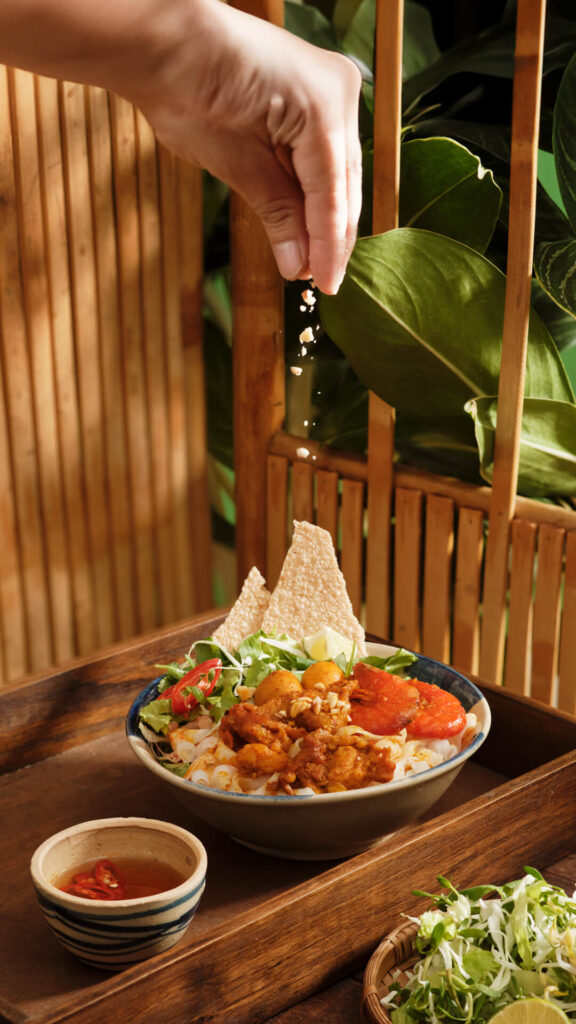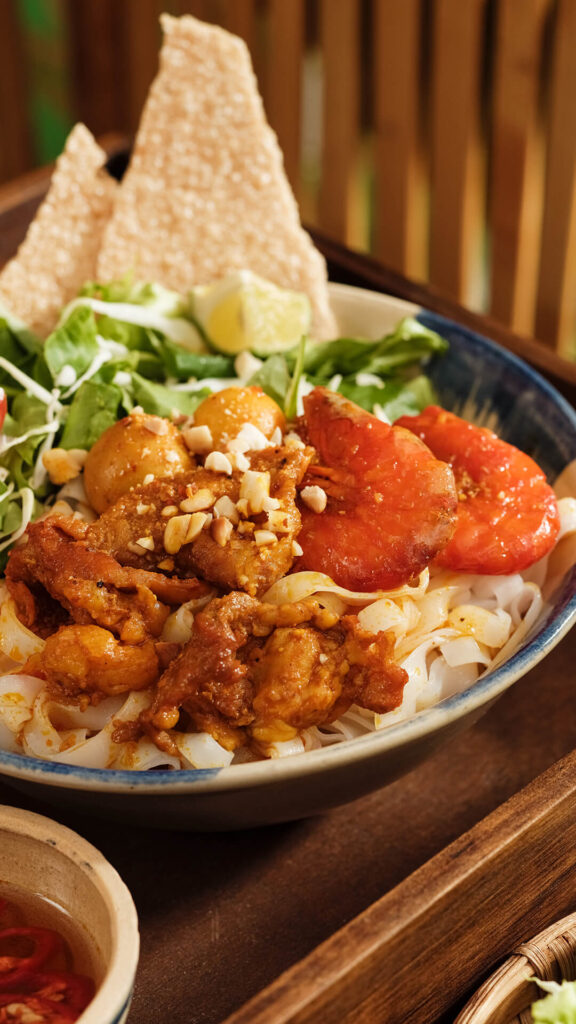Quang Noodles is not merely a dish but a distinctive element of culinary culture that encapsulates the historical journey and folk knowledge of Da Nang City.

ORIGIN AND DEVELOPMENT
Quang Noodles has existed for centuries, accompanying the historical expansion of the Vietnamese people to the South. Although there are no written records specifying its exact origin, traditional cooking tools such as stone grinders, earthen pots, and bamboo baskets — still present in daily life — affirm that Quang Noodles has been an integral part of the Quang–Da region for hundreds of years.
According to oral traditions and folk records, Phu Chiem Village (now belonging to Dien Ban Ward, Da Nang City) is regarded as the birthplace of Quang Noodles. For centuries, the village has been renowned for the famous “Phu Chiem Quang Noodles”, preserving the traditional handmade noodle craft. The noodles are soft yet chewy and elastic, retaining the natural fragrance of rice.
Throughout history, Quang Noodles has become inseparable from the community’s life — present in everyday family meals as well as festivals, ancestral ceremonies, and important events, from rural homes to urban restaurants. Today, Quang Noodles has transcended the boundaries of Da Nang, appearing across Vietnam and even in several countries worldwide, becoming a familiar representative of Vietnamese cuisine.
KNOWLEDGE OF QUANG NOODLES PREPARATION
The main ingredient for Quang Noodles is rice batter made from non-glutinous rice. The rice is cleaned, soaked until softened, and ground finely with a stone mill or grinder. The batter is then mixed with water in a precise ratio – not too thick and not too thin – a balance that depends on each family’s secret know-how rather than a fixed formula.
The steaming process determines the quality of the noodles. The batter is poured evenly onto the cloth steamer using a coconut-shell ladle, then covered and steamed for a few minutes. Once cooked, the noodle sheet is lifted using a flat bamboo stick and layered neatly on a rack. To prevent sticking, the surface is brushed with fragrant peanut oil sautéed with crushed shallots (cu nen). Many families in Da Nang still maintain this manual steaming method to preserve the authentic flavor and texture – unlike machine-made noodles, which tend to break apart when boiled.
Quang Noodles are broader than other types – about one centimeter wide – and now often cut with machines for consistency.
The soul of Quang Noodles lies in its broth and toppings (“nhun”), which vary greatly depending on available ingredients. The most common versions include pork belly with shrimp and quail eggs, or free-range chicken, or freshwater fish. Coastal areas favor shrimp and fish, while midland and mountain regions prefer crab, eel, stream fish, or frog. Regardless of ingredients, authentic Quang Noodles toppings must be sautéed with shallots and turmeric for aroma, then simmered to create a rich, flavorful sauce that blends harmoniously with noodles and herbs.
At restaurants and tourism establishments, chefs have creatively elevated Quang Noodles by incorporating premium ingredients such as lobster, giant freshwater prawn, eel, or conger fish, while maintaining its traditional essence – introducing Da Nang’s culinary culture to international friends.

Fresh herbs are an indispensable part of Quang Noodles. Da Nang residents typically use homegrown herbs like basil, lettuce, coriander, Vietnamese mint, perilla, banana blossoms, shredded morning glory, and bean sprouts. In Hoi An, the famous Tra Que herbs add a distinctive aroma to the dish. Crispy grilled rice crackers sprinkled with black sesame are crumbled into the bowl, adding a fun crunch. The noodles are topped with roasted peanuts, chopped scallions, and cilantro, accompanied by fresh green or red chili – the characteristic spiciness that makes every bite memorable. Together, these elements create a symphony of flavors – rich, nutty, spicy, sour, aromatic, and crunchy – that defines Quang Noodles.


DISTINCTIVE VALUES
The Folk Knowledge of Quang Noodles vividly reflects the character and spirit of Da Nang’s people — diligent, straightforward, witty, and creative in adapting to life’s challenges. Over time, Quang Noodles has become a symbol of local pride and cultural identity — the very soul of Da Nang’s culinary art. It appears in folk verses and poetry, evoking warm memories of homeland. Many artists have drawn inspiration from this humble yet flavorful dish to compose songs and poems celebrating love for their hometown and country.
Moreover, Quang Noodles has been elevated as a “culinary ambassador” of Da Nang, representing the city’s cultural essence in diplomatic events and cultural festivals, showcasing the sophistication of local gastronomy to domestic and international audiences.
EXPERIENTIAL ACTIVITIES
For visitors, Quang Noodles is not just a dish to savor but a cultural experience to enjoy. Many tours and hospitality services in Da Nang feature Quang Noodles as a culinary highlight. Tourists can join cooking classes to learn how to grind rice, steam noodles, and prepare their own steaming-hot bowl of Quang Noodles — an activity that not only delights the palate but also deepens cultural connection with the local way of life.
Travelers can also visit Phu Chiem Village (Dien Ban Ward) to experience the traditional noodle-making craft that has been preserved through generations. There, they can observe handmade noodle workshops, listen to artisans share stories about their craft, and taste the original Phu Chiem Quang Noodles with its rich shrimp, pork, or crab broth — a true flavor of the homeland. Additionally, visitors can take part in local festivals and cultural exchange events, where the golden, fragrant bowls of Quang Noodles always take center stage, attracting crowds eager to savor the culinary essence of Quang land.
The Folk Knowledge of Quang Noodles was recognized by the Ministry of Culture, Sports and Tourism as a National Intangible Cultural Heritage under Decision No. 2327/QĐ-BVHTTDL dated August 9, 2024 – affirming its special status within Vietnam’s treasury of folk knowledge.
DANANG TOURISM PROMOTION CENTER